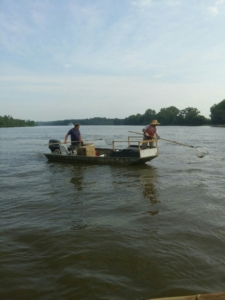VIMS Researchers find that Invasive Blue Catfish are Poised to Expand in the Bay
A recent study from the Virginia Institute of Marine Science (VIMS) found that blue catfish can tolerate higher salinities than previously thought, meaning this invasive species has the potential to expand into mainstem Chesapeake waters, surrounding tributaries, and even the Delaware Bay.
The study’s authors, Ph.D. student Vaskar Nepal and VIMS fisheries professor Mary Fabrizio, examined the salinity tolerance of blue catfish in their non-native Chesapeake Bay habitat. “Salinity is the main limiting factor to blue catfish expansion in the Bay,” explained Nepal. “Understanding how long blue catfish can survive at a given salinity would help us understand how far into the Bay they are likely to go.”
The history of blue catfish

Vaskar Nepal and a commercial fisher collecting blue catfish using electrofishing. (Credit: Charles Frederickson)
Blue catfish are a freshwater species native to the Midwest and highly sought after by recreational fishers. Virginia introduced blue catfish to freshwater stretches of the James, York, and Rappahannock rivers in the 1970s and 1980s with the hopes of creating a new recreational fishery. The population has since exploded in both range and numbers. The estimated population size is about 1.6 million fish residing in a 12-kilometer stretch of the James River; the total population size in the Bay region is not known, but is estimated to be as large as 100 million. Blue catfish are known for being voracious and indiscriminating eaters, consuming other fish, crustaceans, and even other catfish and out-competing native species, like white catfish, for habitat and food.
Testing salinity tolerances
The experiment looked at what levels of salinity would have acute mortality effects on blue catfish to help better understand the extent to which they can colonize areas compared to those where they were originally stocked. Based on a pre-trial study, five different salinity levels were chosen ranging from 0 (freshwater) to 19 psu (practical salinity units) which mirror the seasonal and spatial salinity variation in the Bay and its tributaries. There were 3 tanks per salinity level and 10 fish per tank for a total of 150 fish.
Blue catfish between 165 mm and 265 mm in fork length were collected from the tidal portion of the James River. Nepal explained that they decided to use fish collected from the river as opposed to hatchery fish because it was likely the wild fish had been previously exposed to different salinity levels throughout their lifetime. The blue catfish were gradually acclimatized to increasing salinity levels and their behavior was observed over 72 hours.
Their results showed that blue catfish can survive up to 3 days when exposed to waters less than 15 psu, indicating that they could potentially live in most downstream areas of the Bay’s tributaries, and even use the mainstem of the upper Bay to move into Maryland or Delaware. They also found that survival time was longer with bigger fish. Nepal explained, “Larger fish are able to tolerate these salinities for longer, which means that these bigger fish could exploit high salinity waters.”
Expanding populations
Nepal warns that if blue catfish are able to exploit new habitats, even more resources could be at risk either due to predation or competition. “There are lots of commercially important species that could be in trouble. There are some species we are trying to conserve, like shad and sturgeon, and there’s a possibility blue catfish can undo these conservation efforts.” He clarified that while blue catfish have not been observed eating sturgeon eggs or competing with these species for habitat and food, with millions of blue catfish in the James, you only need a few individuals to have a considerable impact on the sturgeon population.
Climate change could also impact blue catfish expansion. “With climate change, we will probably see different kinds of precipitation regimes like really wet or dry seasons that will affect salinity,” explained Nepal. So, what can be done to prevent blue catfish from migrating further or jumping to the Delaware Bay? Nepal stated that proactivity and vigilance is key. “During these particularly wet months when blue catfish are able to use estuarine waters to expand, we have to be more vigilant in monitoring particular areas and record if blue catfish are moving there. If we can break that corridor, we might be able to limit the expansion because once they get there there’s not much we can do.”
